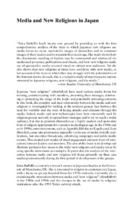Media and New Religions in Japan
Proposal review
| dc.contributor.author | Baffelli, Erica | |
| dc.date.accessioned | 2018-09-03 23:55 | |
| dc.date.accessioned | 2019-10-17 14:56:48 | |
| dc.date.accessioned | 2020-04-01T12:32:05Z | |
| dc.date.available | 2020-04-01T12:32:05Z | |
| dc.date.issued | 2016 | |
| dc.identifier | 1000380 | |
| dc.identifier | OCN: 937719358 | en_US |
| dc.identifier.uri | http://library.oapen.org/handle/20.500.12657/29553 | |
| dc.description.abstract | Japanese "new religions"shinshūkyō have used various media forms for training, communicating with members, presenting their messages, reinforcing or protecting the image of the leader and potentially attracting converts. In this book, the complex and dual relationship between the media and new religions is investigated by looking at the tensions groups face between the need for visibility and the risks of facing attacks and criticism through the media. Indeed, media and new technologies have been extensively used by religious groups not only to spread their messages and to try to reach a wider audience, but also to promote themselves as a highly modern and up-to-date form of religion appropriate for a modern technological age. In the 1980s and early 1990s, some movements, such as Agonshū, Kōfuku no Kagaku and Aum Shinrikyō, came into prominence especially via the use of media (initially pub- lications, but also ritual broadcasts, advertising campaigns and public media events). This created new modes of ritual engagement and new ways of inter- actions between leaders and members. The aim of this book is to develop and illustrate particular key issues in the wider new religions and media nexus by using specific movements as examples. In particular, the analysis of the inter- action between media and new religions will focus primarily on three case studies predominantly during the first period of development of the groups. | |
| dc.language | English | |
| dc.relation.ispartofseries | Routledge Research in religion, media and culture | |
| dc.subject.classification | thema EDItEUR::N History and Archaeology::NH History::NHF Asian history | en_US |
| dc.subject.classification | thema EDItEUR::Q Philosophy and Religion::QR Religion and beliefs::QRA Religion: general | en_US |
| dc.subject.other | Japan | |
| dc.subject.other | religion | |
| dc.subject.other | 1945 | |
| dc.subject.other | mass media | |
| dc.subject.other | Aum Shinrikyo | |
| dc.subject.other | Hikari no Wa | |
| dc.subject.other | Internet | |
| dc.subject.other | Kodansha | |
| dc.subject.other | Manga | |
| dc.subject.other | Om | |
| dc.title | Media and New Religions in Japan | |
| dc.type | book | |
| oapen.relation.isPublishedBy | 7b3c7b10-5b1e-40b3-860e-c6dd5197f0bb | |
| oapen.relation.isbn | 9780415659123; 9780203075036 | |
| oapen.imprint | Routledge | |
| oapen.series.number | 6 | |
| oapen.pages | 192 | |
| oapen.remark.public | Relevant Wikipedia pages: Aum Shinrikyo - https://en.wikipedia.org/wiki/Aum_Shinrikyo; Hikari no Wa - https://en.wikipedia.org/wiki/Hikari_no_Wa; Internet - https://en.wikipedia.org/wiki/Internet; Japan - https://en.wikipedia.org/wiki/Japan; Kodansha - https://en.wikipedia.org/wiki/Kodansha; Manga - https://en.wikipedia.org/wiki/Manga; Mass media - https://en.wikipedia.org/wiki/Mass_media; Om - https://en.wikipedia.org/wiki/Om | |
| oapen.remark.public | 21-7-2020 - No DOI registered in CrossRef for ISBN 9780415659123 | |
| oapen.identifier.ocn | 937719358 | |
| peerreview.anonymity | Single-anonymised | |
| peerreview.id | bc80075c-96cc-4740-a9f3-a234bc2598f1 | |
| peerreview.open.review | No | |
| peerreview.publish.responsibility | Publisher | |
| peerreview.review.stage | Pre-publication | |
| peerreview.review.type | Proposal | |
| peerreview.reviewer.type | Internal editor | |
| peerreview.reviewer.type | External peer reviewer | |
| peerreview.title | Proposal review | |
| oapen.review.comments | Taylor & Francis open access titles are reviewed as a minimum at proposal stage by at least two external peer reviewers and an internal editor (additional reviews may be sought and additional content reviewed as required). |

